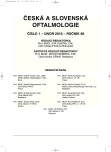The Possibility of the Treatment of Bilateral Macular Edema without the anti VEGF Treatment – a Case Report
Authors:
V. Matušková; D. Vysloužilová
Authors‘ workplace:
Oční klinika FN Brno Bohunice, přednostka prof. MUDr. Eva Vlková CSc.
Published in:
Čes. a slov. Oftal., 66, 2010, No. 1, p. 30-35
Category:
Case Report
Overview
Aim of this case report is to present a case of a female patient with bilateral macular edema successfully treated by the systemic antibiotic.
Material and methods:
The authors present a case of 58 years old female with bilateral cystoid macular edema. In this patient, the central retinal thickness of the right eye was 550 μm, and 600 μm of the left eye. The best-corrected visual acuity (BCVA) of the right eye was 4/10 (0.4) and 4/12 (0.33) of the left eye. The patient underwent complex ophthalmologic examination. During the examination of the posterior pole, there were found no signs of the diabetic changes, or signs of the uveitis. The fluorescein angiography did not prove the presence of the choroidal neovascular membrane or vasculitis. The serological tests (toxoplasmosis, toxocariasis, borreliosis, syphilis – TPHA, RRR), and immunologic tests were performed as well. Toxoplasma positive IgG antibodies were found. According to these serological results, the systemic oral antibiotic treatment was started: clindamycin 300 mg three times daily for 14 days. After the termination of the treatment, improvement of the BCVA to 4/5 (0.8) in both eyes occurred. The OCT examination showed the foveolar depression in both eyes. Two months after the termination of the antibiotic treatment, the relapse of the macular edema occurred (BCVA 4/6 (0.66) in both eyes). According to the consultation with the doctor from the Department of Infectious Diseases, the treatment with clindamycin was started again (300 mg three times daily) for three weeks. After termination of this treatment, the foveolar depression on the OCT examination was evident and the BCVA was 4/4 (1.0) in both eyes (central retinal thickness of the right eye was 215 μm, and of the left eye it was 225 μm). This condition is stable and lasts for more than one year.
Conclusion:
In the differential diagnosis of the bilateral macular edema also the inflammatory etiology should be always considered. According to our experience, the bilateral macular edema may be the only presentation of toxoplasmosis.
Key words:
bilateral macular edema, toxoplasmosis, anti-VEGF, focus of the inflammatory disease
Sources
1. Automatizovaný informační systém léčivých přípravků (AISLIP)
2. Baget-Bernaldiz, M., Soler, L. N., Romero-Aroca, P., Optical coherence tomography study in tamoxifen maculopathy. Arch Soc Esp Oftalmol, 83, 2008: 615–8.
3. Cihelková, I., Souček, P.: Atlas makulárních chorob, Praha, Galen, 2005, 509 str.
4. Fišer I.: Cystoidní makulární edém, 329-336. In: Kuchynka P. a kol.: Oční lékařství, Praha, Grada Publ., 2007, 768s.
5. Kanski J.J.: Clinical Ophthalmology, a systemic Aproach, 3rd ed., Butterworth-Heinemann Ltd, Oxford, 399–401.
6. Říhová E.: Uvea, 440–442. In: Kuchynka P. a kol.: Oční lékařství, Praha, Grada Publ., 2007, 768s.
7. Tan C.S., Teoh S.C., Chan D.P. et al.: Dengue retinopathy manifesting with bilateral vasculitis and macular oedema. Eye, 21, 2007: 875–7.
Labels
OphthalmologyArticle was published in
Czech and Slovak Ophthalmology

2010 Issue 1
Most read in this issue
- Our Two – Years Experience with the Bevacizumab (Avastin) Treatment of the Age Related Macular Degeneration Wet Form
- The Influence of the Lens Capsule Mechanical Polishing to the Secondary Cataract Development
- Bacillus Cereus Keratitis – Case Report
- The Impact of Implantation of Intraocular Lenses with Negative Spherical Aberration on Contrast Sensitivity
